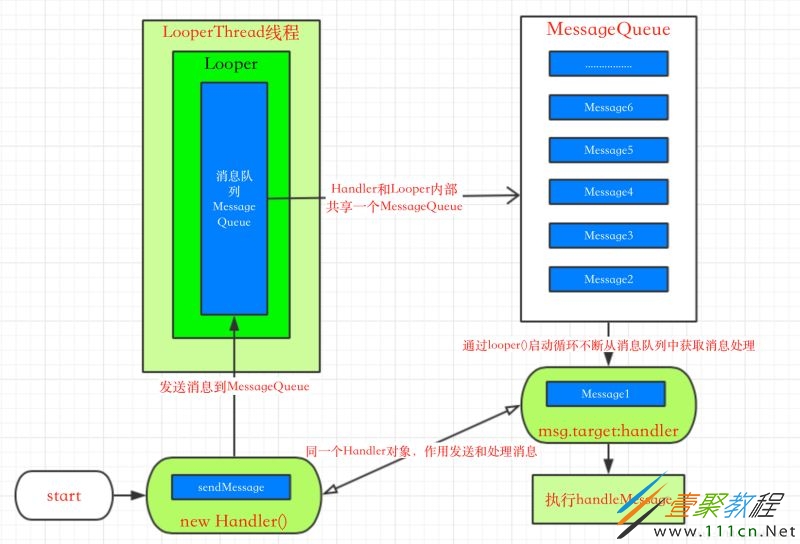最新下载
热门教程
- 1
- 2
- 3
- 4
- 5
- 6
- 7
- 8
- 9
- 10
深入Android Handler,MessageQueue与Looper关系
时间:2022-06-25 22:49:54 编辑:袖梨 来源:一聚教程网
一说到Android的消息机制,自然就会联想到Handler,我们知道Handler是Android消息机制的上层接口,因此我们在开发过程中也只需要和Handler交互即可,很多人认为Handler的作用就是更新UI,这也确实没错,但除了更新UI,Handler其实还有很多其他用途,比如我们需要在子线程进行耗时的I/O操作,可能是读取某些文件或者去访问网络等,当耗时操作完成后我们可能需要在UI上做出相应的改变,但由于Android系统的限制,我们是不能在子线程更新UI控件的,否则就会报异常,这个时候Handler就可以派上用场了,我们可以通过Handler切换到主线程中执行UI更新操作。
下面是Handler一些常用方法:
void handleMessage(Message msg):处理消息的方法,该方法通常会被重写。
final boolean hasMessages(int what):检测消息队列中是否包含what属性为指定值的消息。
Message obtainMessage():获取消息的方法,此函数有多个重载方法。
sendEmptyMessage(int what):发送空消息。
final boolean sendEmptyMessageDelayed(int what , long delayMillis):指定多少毫秒后发送空消息。
final boolean sendMessage(Message msg):立即发送消息。
final boolean sendMessageDelayed(Message msg ,long delayMillis):指定多少毫秒后发送消息。
final boolean post(Runnable r):执行runnable操作。
final boolean postAtTime(Runnable r, long upTimeMillis):在指定时间执行runnable操作。
final boolean postDelayed(Runnable r, long delayMillis):指定多少毫秒后执行runnable操作。
介绍完方法后,我们就从一个简单的例子入手吧,然后一步步的分析:
public class MainActivity extends AppCompatActivity {
public static final int MSG_FINISH = 0X001;
//创建一个Handler的匿名内部类
private Handler handler = new Handler() {
@Override
public void handleMessage(Message msg) {
switch (msg.what) {
case MSG_FINISH:
LogUtils.e("handler所在的线程id是-->" + Thread.currentThread().getName());
break;
}
}
};
@Override
protected void onCreate(Bundle savedInstanceState) {
super.onCreate(savedInstanceState);
setContentView(R.layout.activity_main);
//启动耗时操作
consumeTimeThread(findViewById(R.id.tv));
// handler.post()
}
//启动一个耗时线程
public void consumeTimeThread(View view) {
new Thread() {
public void run() {
try {
LogUtils.e("耗时子线程的Name是--->" + Thread.currentThread().getName());
//在子线程运行
Thread.sleep(2000);
//完成后,发送下载完成消息
handler.sendEmptyMessage(MSG_FINISH);
} catch (InterruptedException e) {
e.printStackTrace();
}
}
}.start();
}
}
运行结果:
上面的例子其实就是Handler的基本使用,在主线中创建了一个Handler对象,然后通过在子线程中模拟一个耗时操作完成后通过sendEmptyMessage(int)方法发送一个消息通知主线程的Handler去执行相应的操作。通过运行结果我们也可以知道Handler确实也是在主线程运行的。
那么问题来了,通过Handler发送的消息是怎么到达主线程的呢?接下来我们就来掰掰其中的奥妙,前方高能,请集中注意力!为了更好的理解Handler的工作原理,我们先来介绍与Handler一起工作的几个组件:
Message:Handler接收和处理消息的对象。
Looper:每个线程只能有一个Looper。它的loop方法负责读取MessageQueue中的消息,读到消息后把消息发送给Handler进行处理。
MessageQueue:消息队列,它采用先进先出的方式来管理Message。程序创建Looper对象时,会在它的构造方法中创建MessageQueue对象。
Handler:它的作用有两个—发送消息和处理消息,程序使用Handler发送消息,由Handler发送的消息必须被送到指定的MessageQueue;否则消息就没有在MessageQueue进行保存了。而MessageQueue是由Looper负责管理的,也就是说,如果希望Handler正常工作的话,就必须在当前线程中有一个Looper对象。我们先对上面的几个组件有大概的了解就好,后面我们都会详细分析,既然消息是从Handler发送出去,那么我们就先从Handler入手吧。先来看看Handler 的构造方法源码:
public class Handler {
/**
* 未实现的空方法handleMessage()
*/
public void handleMessage(Message msg) {
}
/**
* 我们通常用于创建Handler的构造方法之一
*/
public Handler() {
this(null, false);
}
// 构造方法的内调用的this(null, false)的具体实现
public Handler(Callback callback, boolean async) {
//检查Handler是否是static的,如果不是的,那么有可能导致内存泄露
if (FIND_POTENTIAL_LEAKS) {
final Class klass = getClass();
if ((klass.isAnonymousClass() || klass.isMemberClass() || klass.isLocalClass()) &&
(klass.getModifiers() & Modifier.STATIC) == 0) {
Log.w(TAG, "The following Handler class should be static or leaks might occur: " +
klass.getCanonicalName());
}
}
//重要的组件出现啦!Looper我们先理解成一个消息队列的管理者,用来从消息队列中取消息的,后续会详细分析
mLooper = Looper.myLooper();
if (mLooper == null) {
//这个异常很熟悉吧,Handler是必须在有Looper的线程上执行,这个也就是为什么我在HandlerThread中初始化Handler
//而没有在Thread里面初始化,如果在Thread里面初始化需要先调用Looper.prepare方法
throw new RuntimeException(
"Can't create handler inside thread that has not called Looper.prepare()");
}
//将mLooper里面的消息队列复制到自身的mQueue,这也就意味着Handler和Looper是公用一个消息队列
mQueue = mLooper.mQueue;
//回调函数默认是Null
mCallback = null;
}
分析:Handler的构造方法源码不是很多,也比较简单,但是我们从源码中也可以得知,在创建Handler时,Handler内部会去创建一个Looper对象,这个Looper对象是通过Looper.myLooper()创建的(后续会分析这个方法),同时还会创建一个消息队列MessageQueue,而这个MessageQueue是从Looper中获取的,这也就意味着Handler和Looper共用一个消息队列,当然此时Handler,Looper以及MessageQueue已经捆绑到一起了。上面还有一个情况要说明的,那就是:
if (mLooper == null) {
//这个异常很熟悉吧,Handler是必须在有Looper的线程上执行,这个也就是为什么我在HandlerThread中初始化Handler
//而没有在Thread里面初始化,如果在Thread里面初始化需要先调用Looper.prepare方法
throw new RuntimeException(
"Can't create handler inside thread that has not called Looper.prepare()");
}
这里先回去判断Looper是否为空,如果为null,那么就会报错,这个错误对我们来说应该比较熟悉吧,那为什么会报这个错误呢?我们在前面说过Handler的作用有两个—发送消息和处理消息,我们在使用Handler发送消息,由Handler发送的消息必须被送到指定的MessageQueue;否则就无法进行消息循环。而MessageQueue是由Looper负责管理的,也就是说,如果希望Handler正常工作的话,就必须在当前线程中有一个Looper对象。那么又该如何保障当前线程中一定有Looper对象呢?这里其实分两种情况:
(1)在主UI线程中,系统已经初始化好了一个Looper对象,因此我们可以直接创建Handler并使用即可。
(2)在子线程中,我们就必须自己手动去创建一个Looper对象,并且去启动它,才可以使用Handler进行消息发送与处理。使用事例如下:
class childThread extends Thread{
public Handler mHandler;
@Override
public void run() {
//子线程中必须先创建Looper
Looper.prepare();
mHandler =new Handler(){
@Override
public void handleMessage(Message msg) {
super.handleMessage(msg);
//处理消息
}
};
//启动looper循环
Looper.loop();
}
}
分析完Handler的构造方法,我们接着看看通过Handler发送的消息到底是发送到哪里了?我们先来看看Handler的几个主要方法源码:
// 发送一个空消息的方法,实际上添加到MessagerQueue队列中
public final boolean sendEmptyMessage(int what) {
return sendEmptyMessageDelayed(what, 0);
}
// 给上一个方法调用
public final boolean sendEmptyMessageDelayed(int what, long delayMillis) {
Message msg = Message.obtain();
msg.what = what;
return sendMessageDelayed(msg, delayMillis);
}
// 给上一个方法调用
public final boolean sendMessageDelayed(Message msg, long delayMillis) {
if (delayMillis < 0) {
delayMillis = 0;
}
return sendMessageAtTime(msg, SystemClock.uptimeMillis() + delayMillis);
}
// 给上一个方法调用
public boolean sendMessageAtTime(Message msg, long uptimeMillis) {
MessageQueue queue = mQueue;
if (queue == null) {
RuntimeException e = new RuntimeException(this
+ " sendMessageAtTime() called with no mQueue");
Log.w("Looper", e.getMessage(), e);
return false;
}
return enqueueMessage(queue, msg, uptimeMillis);
}
// 最后调用此方法添加到消息队列中
private boolean enqueueMessage(MessageQueue queue, Message msg,
long uptimeMillis) {
msg.target = this;// 设置发送目标对象是Handler本身
if (mAsynchronous) {
msg.setAsynchronous(true);
}
return queue.enqueueMessage(msg, uptimeMillis);// 添加到消息队列中
}
// 在looper类中的loop()方法内部调用的方法
public void dispatchMessage(Message msg) {
if (msg.callback != null) {
handleCallback(msg);
} else {
if (mCallback != null) {
if (mCallback.handleMessage(msg)) {
return;
}
}
handleMessage(msg);
}
}
分析:通过源码我们可以知道,当我们调用sendEmptyMessage(int)发送消息后。最终Handler内部会去调用enqueueMessage(MessageQueue queue,Message msg)方法把发送的消息添加到消息队列MessageQueue中,同时还有设置msg.target=this此时就把当前handler对象绑定到msg.target中了,这样就完成了Handler向消息队列存放消息的过程。这个还有一个要注意的方法 dispatchMessage(Message),这个方法最终会在looper中被调用(这里我们先知道这点就行,后续还会分析)。话说我们一直在说MessageQueue消息队列,但这个消息队列到底是什么啊?其实在Android中的消息队列指的也是MessageQueue,MessageQueue主要包含了两种操作,插入和读取,而读取操作本身也会伴随着删除操作,插入和读取对应的分别是enqueueMessage和next,其中enqueueMessage是向消息队列中插入一条消息,而next的作用则是从消息队列中取出一条消息并将其从队列中删除。虽然我们一直称其为消息队列但是它的内部实现并不是队列,而是通过一个单链表的数据结构来维护消息列表的,因为我们知道单链表在插入和删除上比较有优势。至内MessageQueue的内部实现,这个属于数据结构的范畴,我们就不过多讨论了,还是回到原来的主题上来,到这里我们都知道Handler发送的消息最终会添加到MessageQueue中,但到达MessageQueue后消息又是如何处理的呢?还记得我们前面说过MessageQueue是由Looper负责管理的吧,现在我们就来看看Looper到底是如何管理MessageQueue的?
public final class Looper {
// sThreadLocal.get() will return null unless you've called prepare().
//存放线程的容器类,为确保获取的线程和原来的一样
static final ThreadLocal sThreadLocal = new ThreadLocal();
private static Looper sMainLooper; // guarded by Looper.class
//消息队列
final MessageQueue mQueue;
final Thread mThread;
//perpare()方法,用来初始化一个Looper对象
public static void prepare() {
prepare(true);
}
private static void prepare(boolean quitAllowed) {
if (sThreadLocal.get() != null) {
throw new RuntimeException("Only one Looper may be created per thread");
}
sThreadLocal.set(new Looper(quitAllowed));
}
//handler调用的获取Looper对象的方法。实际是在ThreadLocal中获取。
public static Looper myLooper() {
return sThreadLocal.get();
}
//Looper类的构造方法,可以发现创建Looper的同时也创建了消息队列MessageQueue对象
private Looper(boolean quitAllowed) {
mQueue = new MessageQueue(quitAllowed);
mRun = true;
mThread = Thread.currentThread();
}
//这个方法是给系统调用的,UI线程通过调用这个线程,从而保证UI线程里有一个Looper
//需要注意:如果一个线程是UI线程,那么myLooper和getMainLooper是同一个Looper
public static final void prepareMainLooper() {
prepare();
setMainLooper(myLooper());
if (Process.supportsProcesses()) {
myLooper().mQueue.mQuitAllowed = false;
}
}
//获得UI线程的Looper,通常我们想Hanlder的handleMessage在UI线程执行时通常会new Handler(getMainLooper());
public synchronized static final Looper getMainLooper() {
return mMainLooper;
}
//looper中最重要的方法loop(),该方法是个死循环,会不断去消息队列MessageQueue中获取消息,然后调dispatchMessage(msg)方法去执行
public static void loop() {
final Looper me = myLooper();
if (me == null) {
throw new RuntimeException("No Looper; Looper.prepare() wasn't called on this thread.");
}
final MessageQueue queue = me.mQueue;
//死循环
for (;;) {
Message msg = queue.next(); // might block
if (msg == null) {
// No message indicates that the message queue is quitting.
return;
}
//这里其实就是调用handler中的方法,而在Handler的源码中也可以知道dispatchMessage(msg)内部调用的就是handlerMessage()方法
msg.target.dispatchMessage(msg);
msg.recycle();
}
}
分析:代码不算多,我们拆分开慢慢说,在Looper源码中我们可以得知其内部是通过一个ThreadLocal的容器来存放Looper的对象本身的,这样就可以确保每个线程获取到的looper都是唯一的。那么Looper对象是如何被创建的呢?通过源码我们可以知道perpare()方法就可以创建Looper对象:
//perpare()方法,用来初始化一个Looper对象
public static void prepare() {
prepare(true);
}
private static void prepare(boolean quitAllowed) {
if (sThreadLocal.get() != null) {
throw new RuntimeException("Only one Looper may be created per thread");
}
sThreadLocal.set(new Looper(quitAllowed));
}
在创建Looper对象前先会去判断ThreadLocal中是否已经存在Looper对象,如果不存在就新创建一个Looper对象并且存放ThreadLocal中。这里还有一个要注意的是在Looper创建的同时MessageQueue消息队列也被创建完成,这样的话Looper中就持有了MessageQueue对象。
//Looper类的构造方法,可以发现创建Looper的同时也创建了消息队列MessageQueue对象
private Looper(boolean quitAllowed) {
mQueue = new MessageQueue(quitAllowed);
mRun = true;
mThread = Thread.currentThread();
}
那么我们如何获取已经创建好的Looper对象呢?通过源码我们知道myLooper()方法就可以获取到Looper对象:
//handler调用的获取Looper对象的方法。实际是在ThreadLocal中获取。
public static Looper myLooper() {
return sThreadLocal.get();
}
Looper对象的创建和获取,还有MessageQueue对象的创建,现在我们都很清楚了,但是Looper到底是怎么管理MessageQueue对象的呢?这就要看looper()方法了:
//looper中最重要的方法loop(),该方法是个死循环,
//会不断去消息队列MessageQueue中获取消息,
//然后调dispatchMessage(msg)方法去执行
public static void loop() {
final Looper me = myLooper();
if (me == null) {
throw new RuntimeException("No Looper; Looper.prepare() wasn't called on this thread.");
}
final MessageQueue queue = me.mQueue;
//死循环
for (;;) {
Message msg = queue.next(); // might block
if (msg == null) {
// No message indicates that the message queue is quitting.
return;
}
//这里其实就是调用handler中的方法,而在Handler的源码中也可以知道dispatchMessage(msg)内部调用的就是handlerMessage()方法
msg.target.dispatchMessage(msg);
msg.recycle();
}
通过looper()方法内部源码我们可以知道,首先会通过myLoooper()去获取一个Looper对象,如果Looper对象为null,就会报出一个我们非常熟悉的错误提示,“No Looper;Looper.prepare() wasn't called on this thread”,要求我们先通过Looper.prepare()方法去创建Looper对象;如果Looper不为null,那么就会去获取消息队列MessageQueue对象,接着就进入一个for的死循环,不断从消息队列MessageQueue对象中获取消息,如果消息不为空,那么久会调用msg.target的dispatchMessage(Message)方法,那么这个target又是什么,没错target就是我们创建的Handler对象,还记得我们前面分析Handler源码时说过的那个方法嘛?
// 在looper类中的loop()方法内部调用的方法
public void dispatchMessage(Message msg) {
if (msg.callback != null) {
handleCallback(msg);
} else {
if (mCallback != null) {
if (mCallback.handleMessage(msg)) {
return;
}
}
handleMessage(msg);
}
现在明白了吧?首先,检测Message的callback是否为null,不为null就通过handleCallback方法来处理消息,那么Message的callback是什么?其实就是一个Runnable对象,实际上就是Handler的post方法所传递的Runnable参数,我们顺便看看post方法源码:
public final boolean post(Runnable r)
{
return sendMessageDelayed(getPostMessage(r), 0);
}
现在明白Message的callback是什么了吧?而对应handleCallback方法逻辑也比较简单:
private static void handleCallback(Message message) {
message.callback.run();
}
嗯,是的,因此最终执行的还是通过post方法传递进来的Runnable参数的run方法。好了,我们继续dispatchMessage()方法的分析,接着会去检查mCallback是否为null,不为null,则调用mCallback的handleMessage方法来处理消息。至于Callback则就是一个接口定义如下:
/**
* Callback interface you can use when instantiating a Handler to avoid
* having to implement your own subclass of Handler.
*
* @param msg A {@link android.os.Message Message} object
* @return True if no further handling is desired
*/
public interface Callback {
public boolean handleMessage(Message msg);
}
这个接口有什么用呢?其实通过Callback接口我们就可以采取如下方法来创建Handler对象:
Handler handler =new Handler(callback)
那么这样做到底有什么意义,其实这样做可以用callback来创建一个Handler的实例而无需派生Handler的子类。在我们的开发过程中,我们经常使用的方法就是派生一个Hanlder子类并重写其handleMessage方法来处理具体的消息,而Callback给我们提供了另外一种方式,那就是当我们不想派生子类的时候,可以通过Callback来实现。继续dispatchMessage()方法的分析,最后如果以上条件都不成立的话,就会去调用Handler的handleMessage方法来处理消息。而 我们的Handler是在主线程创建的,也就是说Looper也是主线程的Looper,因此handleMessage内部处理最终都会在主线程上执行,就这样整个流程都执行完了。下面提供一个图解帮助大家理解:
最后我们来个小总结:Android中的Looper类主要作用是来封装消息循环和消息队列的,用于在android线程中进行消息处理。handler是用来向消息队列中插入消息的并最好对消息进行处理。
(1) Looper类主要是为每个线程开启的单独的消息循环。 默认情况下android中新诞生的线程是没有开启消息循环的。(主线程除外,主线程系统会自动为其创建Looper对象,开启消息循环) Looper对象负责管理MessageQueue,而MessageQueue主要是用来存放handler发送的消息,而且一个线程只能有一个Looper,对应一个MessageQueue。
(2) 我们通常是通过Handler对象来与Looper进行交互的。Handler可看做是Looper的一个接口,用来向指定的Looper中的MessageQueue发送消息并且Handler还必须定义自己的处理方法。 默认情况下Handler会与其被定义时所在线程的Looper绑定,如Handler在主线程中定义,它是与主线程的Looper绑定。 mainHandler = new Handler() 等价于 new Handler(Looper.myLooper())Looper.myLooper():获取当前进程的looper对象, Looper.getMainLooper() 用于获取主线程的Looper对象。
(3) 在非主线程中直接new Handler() 会报如下的错误: Can't create handler inside thread that has not called Looper.prepare() 原因是非主线程中默认没有创建Looper对象,需要先调用Looper.prepare()启用Looper,然后再调用Looper.loop()。
(4) Looper.loop():启动looper中的循环线程,Handler就会从消息队列里取消息并进行对应处理。 最后要注意的是写在Looper.loop()之后的代码不会被执行,这个函数内部应该是一个循环,当调用mHandler.getLooper().quit()后,loop()才会中止,其后的代码才能得以运行。
相关文章
- 《鸣潮》2.3前瞻兑换码大全 04-21
- 《弓箭传说2》新手玩法介绍 01-16
- 《地下城与勇士:起源》断桥烟雨多买多送活动内容一览 01-16
- 《差不多高手》醉拳龙技能特点分享 01-16
- 《鬼谷八荒》毕方尾羽解除限制道具推荐 01-16
- 《地下城与勇士:起源》阿拉德首次迎新春活动内容一览 01-16
















